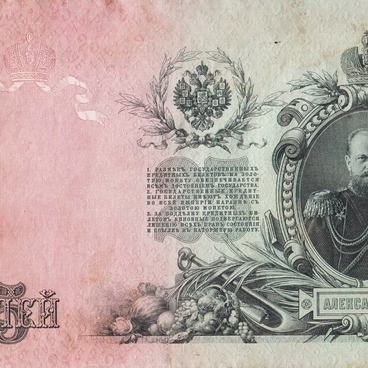A 100-ruble banknote of 1910 is one of the most interesting ones from an artistic point of view. It was designed by Rihards Germanovich Zariņš and Rudolf Rössler. The latter had already developed ornate designs for money in the late 19th century.
Numerous details in the design are symbolic. For example, the palm and laurel branches on the obverse represent victory and peace, while the fruit on the same side of the banknote signifies abundance. This symbolism is typical of the design of banknotes issued at the turn of the 20th century. There is an image of Catherine the Great on the banknote. Thanks to the portrait the banknote was popularly nicknamed “katenka”. It was under Catherine in 1769 when printing paper money started. The portrait of the Empress on the banknote was based on the portrait by Johann Baptist Lampi, a famous court painter of the late 18th century, which was created in 1792. The banknote was put into circulation in 1911.
Putting a portrait of Empress Catherine the Great on such a large banknote is a sign of recognition of Russia’s achievements during her reign. These include a number of major foreign policy gains: victories in two wars with the Ottoman Empire, which culminated in Russia gaining access to the Black Sea and strengthening its position in that region; a number of major victories in the war with Sweden in 1788–1790, which prevented the neighboring country from revising the results of the Treaty of Nystadt, signed back in the time of Peter the Great; the partitions of the Polish-Lithuanian Commonwealth led to the return to Russia of a number of Russian ancestral territories with an Orthodox population living on them (Belarus, Right Bank Ukraine). A major success was the creation of a system of armed neutrality during Britain’s war with the North American colonies and their allies in Europe, which protected the merchant ships of both the Russian Empire and several other European states that had joined or supported the system. Domestic policy also saw a number of reforms: secularisation of church lands, Charter to the nobility, Charter to the towns, Manifesto on the freedom of enterprise, administrative reform, building a fleet on the Black Sea and the convening of the Legislative (Ulozhennaya) Commission (although its activity was inconclusive).
Such banknotes could not be in circulation for long, as they were used mainly for large sums of money in trade transactions.
Numerous details in the design are symbolic. For example, the palm and laurel branches on the obverse represent victory and peace, while the fruit on the same side of the banknote signifies abundance. This symbolism is typical of the design of banknotes issued at the turn of the 20th century. There is an image of Catherine the Great on the banknote. Thanks to the portrait the banknote was popularly nicknamed “katenka”. It was under Catherine in 1769 when printing paper money started. The portrait of the Empress on the banknote was based on the portrait by Johann Baptist Lampi, a famous court painter of the late 18th century, which was created in 1792. The banknote was put into circulation in 1911.
Putting a portrait of Empress Catherine the Great on such a large banknote is a sign of recognition of Russia’s achievements during her reign. These include a number of major foreign policy gains: victories in two wars with the Ottoman Empire, which culminated in Russia gaining access to the Black Sea and strengthening its position in that region; a number of major victories in the war with Sweden in 1788–1790, which prevented the neighboring country from revising the results of the Treaty of Nystadt, signed back in the time of Peter the Great; the partitions of the Polish-Lithuanian Commonwealth led to the return to Russia of a number of Russian ancestral territories with an Orthodox population living on them (Belarus, Right Bank Ukraine). A major success was the creation of a system of armed neutrality during Britain’s war with the North American colonies and their allies in Europe, which protected the merchant ships of both the Russian Empire and several other European states that had joined or supported the system. Domestic policy also saw a number of reforms: secularisation of church lands, Charter to the nobility, Charter to the towns, Manifesto on the freedom of enterprise, administrative reform, building a fleet on the Black Sea and the convening of the Legislative (Ulozhennaya) Commission (although its activity was inconclusive).
Such banknotes could not be in circulation for long, as they were used mainly for large sums of money in trade transactions.




